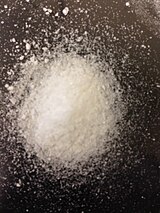Our website is made possible by displaying online advertisements to our visitors.
Please consider supporting us by disabling your ad blocker.
Sodium perrhenate
 | |
 | |
| Names | |
|---|---|
| Other names
Sodium rhenate(VII)
| |
| Identifiers | |
3D model (JSmol)
|
|
| ChEMBL | |
| ECHA InfoCard | 100.033.388 |
PubChem CID
|
|
| RTECS number |
|
| UNII | |
CompTox Dashboard (EPA)
|
|
| |
| |
| Properties | |
| NaReO4 | |
| Molar mass | 273.1866 g/mol |
| Appearance | white solid |
| Density | 5.39 g/cm3 |
| Melting point | 414 °C (777 °F; 687 K) |
| 103.3 g/100 mL (0 °C) 114.0 g/100 mL (25 °C)[1] 145.3 g/100 mL (30 °C) 173.0 g/100 mL (50 °C) | |
| Solubility | soluble in water (> 1130 g/L at 25 °C)[1] |
| Structure | |
| tetragonal | |
| Hazards | |
| Occupational safety and health (OHS/OSH): | |
Main hazards
|
Oxidizer, skin/eyes irritation |
Except where otherwise noted, data are given for materials in their standard state (at 25 °C [77 °F], 100 kPa).
| |
Sodium perrhenate (also known as sodium rhenate(VII)) is the inorganic compound with the formula NaReO4. It is a white salt that is soluble in water. It is a common precursor to other rhenium compounds. Its structure resembles that of sodium perchlorate and sodium permanganate.
- ^ a b Luis Cifuentes, J. M. Casas (February 2012). "Crystallization of Sodium Perrhenate from NaReO4–H2O–C2H5OH Solutions at 298 K". Hydrometalurgy. 113–114: 192–194. Bibcode:2012HydMe.113..192C. doi:10.1016/j.hydromet.2011.12.022.
Previous Page Next Page


